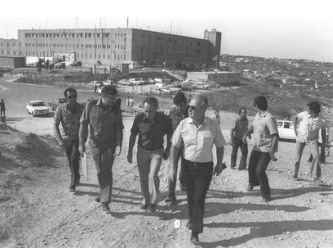Pages in Section 14

The Evacuation of Hebron
ii. Evacuation - Hebron
iii. evacuation - Bassa
iv. Safad
v. Tiberias
vi. Haifa
vii. Jaffa?
viii. The last Day
Stand down
Next - Old Comrades and New Ventures
 Hebron was in the section of Palestine the UN had allocated to the Arabs. Its tegart was the largest in Palestine.
Hebron was in the section of Palestine the UN had allocated to the Arabs. Its tegart was the largest in Palestine.
The photograph shows the tegart in 1978, taken from 'Back to Hebron’s Tegart Fort' by Oded Löwenheim. For an excellent description of Hebron tegart, download the PDF version of Oded Löwenheim's memoir.
Barry Forrest-Jones, a young British constable in 1948, describes how the British police left Hebron on February 12th
"We all knew that our departure was imminent but there was a degree of secrecy as to exactly when we would be moving. We had been ready for some days andnow wanted to be on the way although our future destination was unknown. We had for some time been burning sensitive documents. Everything in the Police Station was to be left behind with the exception of the motley assortment of vehicles that would convey us and our possessions. There was no doubt in our minds that when we pulled out the Palestinians would move in. Our relationship with the Arabs was good and we did not anticipate trouble but we still had to be prepared.Moving day arrived - an early start in our assortment of vehicles - we all hoped they would get us to our destination -which turned out to be an area of Jerusalem known as the German Colony. In this area was a compound comprising traditional wooden huts which were to be our living quarters. The whole was protected by a barbed wire fence. The entrance was a strong metal gate with a manned guard house nearby; two lookout towers were situated at the perimeter. Our huts were quickly allocated and we settled in. We had no idea how long we would stay here."
(Does anyone recognize this billet. Did it have a name? Can anyone pinpoint it on a map?)